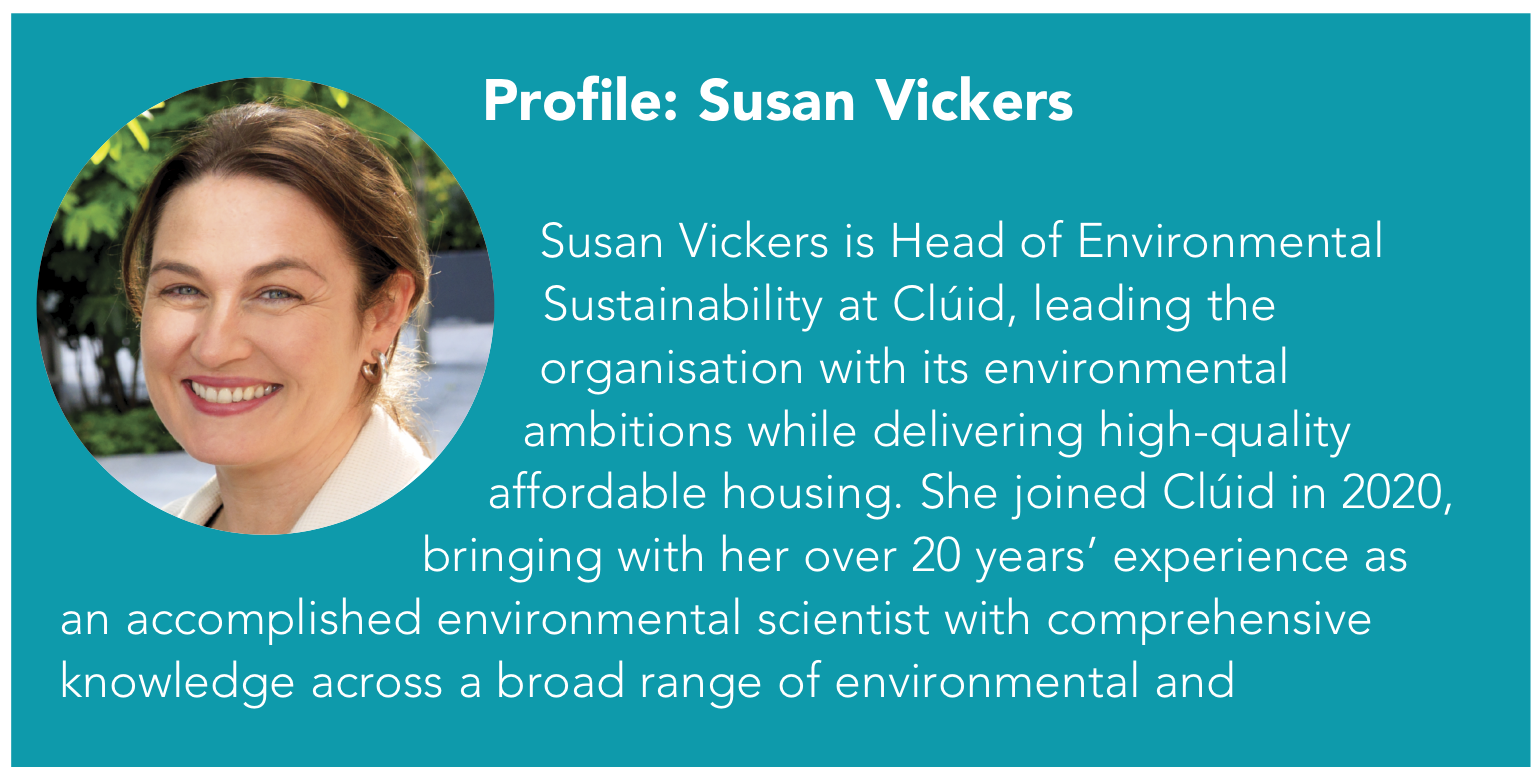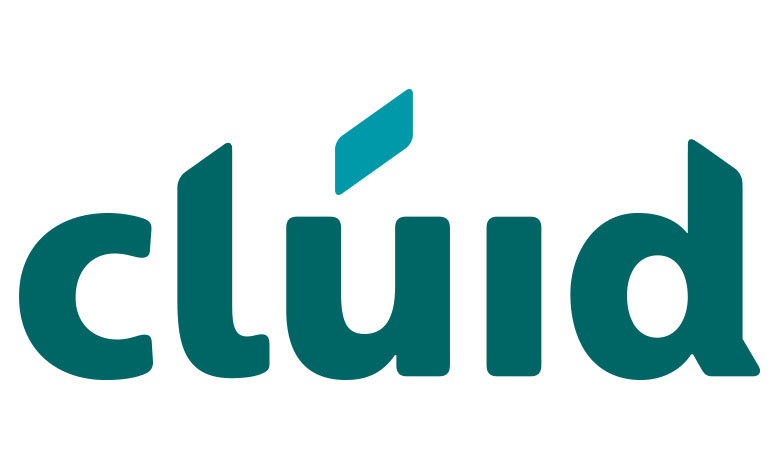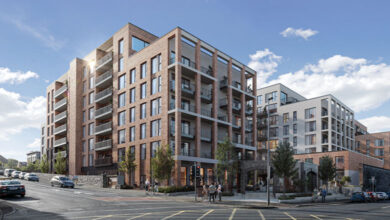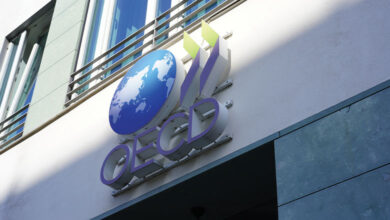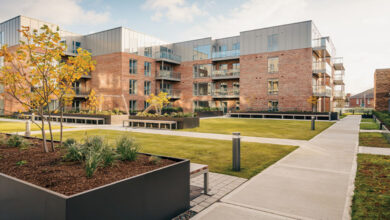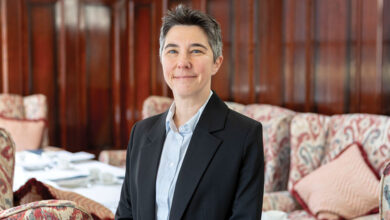Building sustainably
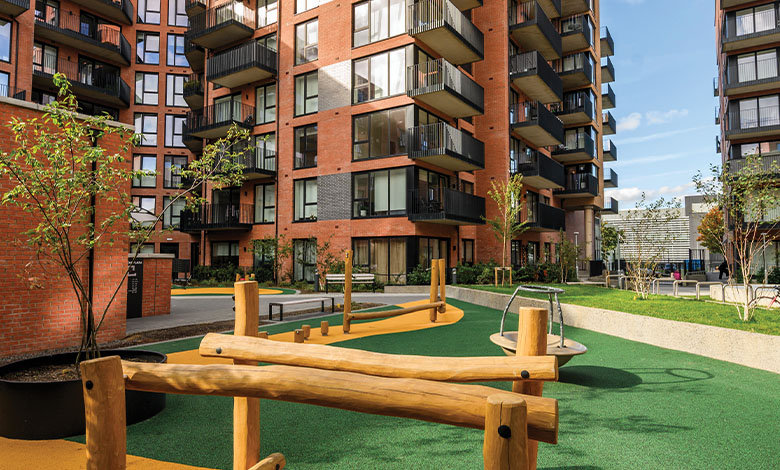
Susan Vickers, Head of Environmental Sustainability at Clúid, speaks to eolas Magazine about the steps the organisation is taking to deliver on climate targets and how this can benefit residents.
Clúid’s greening strategy, Building a Sustainable Future Together, sets an aim to ensure everyone in society has a “great place to live”. It underpins Clúid’s intention to create sustainable homes and communities, reduce the organisation’s environmental impact, and contribute to the State’s climate goals. The greening strategy sets a pathway for Clúid’s vision for 2030 of building homes that do not cost the Earth.
Vickers explains: “The greening strategy was developed to identify the organisation’s environmental sustainability and climate goals and set a pathway to achieving them. It is based on three pillars: Be Green, Live Green and Build Green. That encompasses everything we want to do.”
Under the Build Green pillar, Clúid has set an overarching goal for all new homes to be net zero operational carbon, produce 40 per cent less embodied carbon, and for existing homes to be retrofitted to a minimum BER B2 rating.
“In 2022, we started exploring how best to establish a methodology to (a) measure; and (b) report on the embodied carbon of our builds. To work towards this, our procurement manager, Amy O’Farrell, identified an opportunity to establish an innovation partnership which would focus on lean construction, minimising construction waste, and embodied carbon reduction in our new design and build properties,” says Vickers.
In December 2023, Clúid concluded a partnering agreement with Gem Construction with the first project awarded under the agreement in early 2024. It is aimed at delivering a multi-year building programme to develop an additional framework and a methodology to report on lean construction, construction waste, and embodied carbon reduction.
Eibhlin O’Connor, Chief Commercial Officer at Clúid, expands on this: “Clúid is committed to delivering high-quality, sustainable homes across Ireland. We are continuously investing in new and innovative ways to meet the ambitious housing targets that are required to tackle the housing crisis.
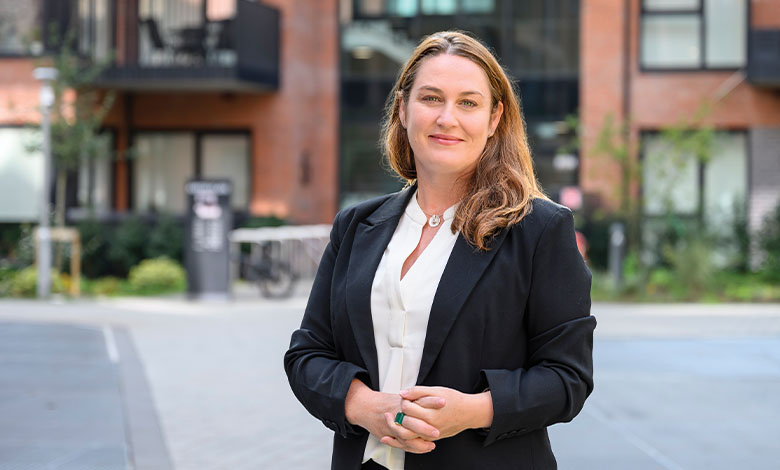
“Reducing energy poverty among our residents is a key priority for Clúid. Deep retrofit measures typically deliver annual energy savings of around €1,170 per household, providing a significant and tangible benefit to household budgets.”
“We have appointed GEM Construction as our first Innovation Partner to help us streamline the building process through early contractor engagement, working alongside our in-house team of experts right from the feasibility and pre-planning stages.
Vickers explains: “In early 2025, we set the baseline figures and sustainability KPIs for the partnership. This initiative will play a key role in guiding us to improve each project’s performance while exploring the smartest, most effective ways to meet our sustainability goals.
“It is a very ambitious partnership which could potentially save about 12 months in the development process and advance the establishment of methodologies to reduce embodied carbon to meet our 2030 targets.
“The partnership focuses on collaboration and early contractor engagement between Clúid and Gem and their design team. This ensures that Gem’s building expertise and the agreed sustainability KPIs are included in the project design at the earliest stages. It also ensures that we are working together to manage the project costs, programme, sustainability, and quality outcomes.”
Vickers notes that a comprehensive cost analysis of the embodied carbon reduction and other KPIs, is essential to ensure continued progress within the partnership. “This analysis will enable us to balance our sustainability ambitions with financial feasibility,” she explains.
“As sustainable construction practices continue to evolve rapidly, we will have the opportunity to explore alternative materials and innovative methodologies, integrating them into our future builds.”
Retrofitting
The greening strategy sets a commitment to establishing a retrofitting programme in all existing Clúid homes to improve their building energy rating (BER) to B2. This aligns with the European Commission’s Energy Performance of Buildings Directive EU/31/2010 (revised in 2018).
Clúid’s retrofit activities include insulation, LED lighting, more efficient heating systems, and the installation of new doors and windows. Exemplifying this, the €23 million regeneration project of St Mary’s Mansions in northeast inner city Dublin, completed in September 2020, saw 200 photovoltaic panels installed and all apartments retrofitted to an A-3 rating.
Clúid has also partnered with EnergyCloud, a social enterprise supported by Irish utilities providers and the wind energy industry, to increase energy efficiency and enable residents to reduce their energy bills.
“With them, we trialled redirecting excess energy, that would otherwise be wasted, to provide tanks of free hot water to residents during the night. We are proud to see EnergyCloud expand and develop both within and outside Ireland. We are always seeking to innovate and utilise our developments as test-bed projects where possible,” explains Vickers.
“Providing high-quality homes is a core priority for Clúid. We are proud that 61 per cent of our homes currently hold an A-rated BER, with a further 16 per cent rated B. Our retrofit programme, one of the most ambitious in the sector, is led by our Head of Asset Management, Brendan Cunningham.
Cunningham says: “Launched in 2018, the programme has delivered upgrades to 2,161 homes between 2018 and 2024, at a total investment of €48.7 million; half of which was supported by the Sustainable Energy Authority of Ireland, the remainder was funded directly by Clúid. These efforts reflect our commitment to energy efficiency, sustainability, and improving living conditions for our residents.
“Reducing energy poverty among our residents is a key priority for Clúid. Deep retrofit measures typically deliver annual energy savings of around €1,170 per household, providing a significant and tangible benefit to household budgets.”
Biodiversity
Vickers outlines how Clúid identifies gaps in biodiversity guidance in housing developments: “In exploring ways to strengthen Clúid’s approach to protecting and enhancing biodiversity, it became clear there was a lack of a meaningful landscape and biodiversity guide for public and communal open spaces in Irish housing developments, particularly for new and planned schemes.
“The built environment has a huge impact on biodiversity and therefore has the potential to drive significant positive change. This is especially important in light of the Government’s housing targets in the coming years, as we work to address Ireland’s substantial housing crisis. Around 50 per cent of our properties are direct design and build, so it is crucial to consider sustainable building elements which the biodiversity guide can assist in.”
“Achieving sustainable housing developments requires money and collaboration is key in ensuring we acquire better funding for the sector.”
To positively influence biodiversity outcomes in our developments, Clúid developed a comprehensive guide outlining landscaping and biodiversity design requirements for all new schemes. The guide, endorsed by the All Ireland Pollinator Plan, is intended to provide developers, construction contractors, landscape architects, horticulturalists, and other stakeholders with clear, practical guidance to design and plant public and communal open spaces in ways that protect and enhance biodiversity.
Vickers explains: “To ensure the guide delivers its full potential impact, it was designed to be accessible, understandable, and relevant to the wide range of roles involved in landscaping and biodiversity decisions. Its development drew on the expertise of our architects in Clúid’s Commercial Development department, with Landscape Designer Ingrid Swan playing a key role in shaping the guidance and ensuring it is practical and actionable across Clúid’s developments.”
Vickers worked closely with Dean Murphy, Senior Project Manager – Design and Placemaking at Clúid, to develop the organisation’s new Design Guide 2025-2030. Dean states: “Clúid’s updated Design Guide focuses on creating attractive, sustainable communities with a strong sense of place. It aims to ensure Clúid homes are comfortable, secure, easy to use, and maintain. The guide is the result of extensive consultation with residents, staff, and stakeholders like the Department of Housing, Local Government and Heritage.
“The guide emphasises the importance of creating a sense of place and attractive communities within residential developments. It promotes sustainable building practices and aims to develop housing that enhances the lives of residents and integrates well with the wider community. Incorporating Clúid’s Landscaping and Biodiversity Guide supports the integration of nature into developments, promoting biodiversity and sustainability.”
Airton Plaza
Vickers identifies the development of Airton Plaza on the Belgard Road in Dublin as an exemplar of what approved housing bodies (AHBs) can achieve for residents while working towards climate targets.
Consisting of 230 A2-rated cost rental homes and 93 general needs social homes, the plaza is strategically located near vital services including Tallaght Hospital and TU Dublin Tallaght campus, amenities such as the Belgard Retail Park and The Square shopping centre, and transport links including bus and Luas routes. The homes in this new neighbourhood are spread across two main blocks connected by a central landscape courtyard. Airton features commercial spaces, retail units, a crèche, an outdoor communal space, and a children’s play area.
Vickers states that the plaza is Home Performance Index (HPI)-certified, demonstrating the value it delivers for residents. HPI is Ireland’s first national certification system for quality and sustainable residential developments. Developed by the Irish Green Building Council (IGBC), it offers a comprehensive framework for assessing the environmental, social, and economic performance of new homes.
Collaboration
Collaboration across the social housing sector is essential to achieving climate action goals while delivering social and economic value. “It is vital that we work together as a sector to share knowledge, learn from each other, and advocate for greater support to meet our environmental sustainability and climate targets,” says Vickers.
Clúid actively engages with stakeholders to advance sustainability initiatives. In 2023 the Housing Alliance established a Climate Action Working Group (CAWG), which Vickers proudly chairs. The group’s primary aim is to provide support on climate action and sustainability matters.
That same year, the Alliance published a research report it commissioned, funded by The Housing Agency, titled Providing Environmental Leadership in Social Housing to Advance Climate Action Goals. Building on that work, the Housing Alliance and The Housing Agency co-funded a follow-up research report, A Playbook on Innovative Solutions to Advancing Net-Zero Carbon in Social Housing, scheduled for release in November 2025.
The CAWG is currently collaborating with the Irish Council for Social Housing (ICSH), working together to secure greater retrofit funding for the sector.
Prioritising environmental sustainability
Looking ahead, Vickers outlines both opportunities and challenges. “Many approved housing bodies are making strong contributions in sustainability and climate action. While Clúid strives to lead, where possible, the sector as a whole must collaborate to achieve our climate goals. As social housing providers, we recognise the importance of value for money, and through aggregation, we can deliver significant climate action and retrofit outcomes, provided there is adequate support and funding.”
She adds: “With ambitious house-building targets alongside climate and biodiversity crises, it is critical that we prioritise environmental sustainability in every project we undertake.”
Vickers emphasises that Clúid is motivated by a desire to drive sector-wide progress and sustainability. She praises outgoing CEO Brian O’Gorman for fostering a culture that places sustainability at the organisation’s core, describing him as “admirably forward-thinking around sustainability”.
Vickers expands on what motivates Clúid to continue leading in the AHB sector: “Clúid is committed to creating sustainable and thriving communities. It is an organisation driven by an ambition to innovate and provide best practice templates that others can follow.”
Concluding, Vickers says: “Achieving sustainable housing developments requires money and collaboration is key in ensuring we acquire better funding for the sector. There is a lot that needs to be done.”
